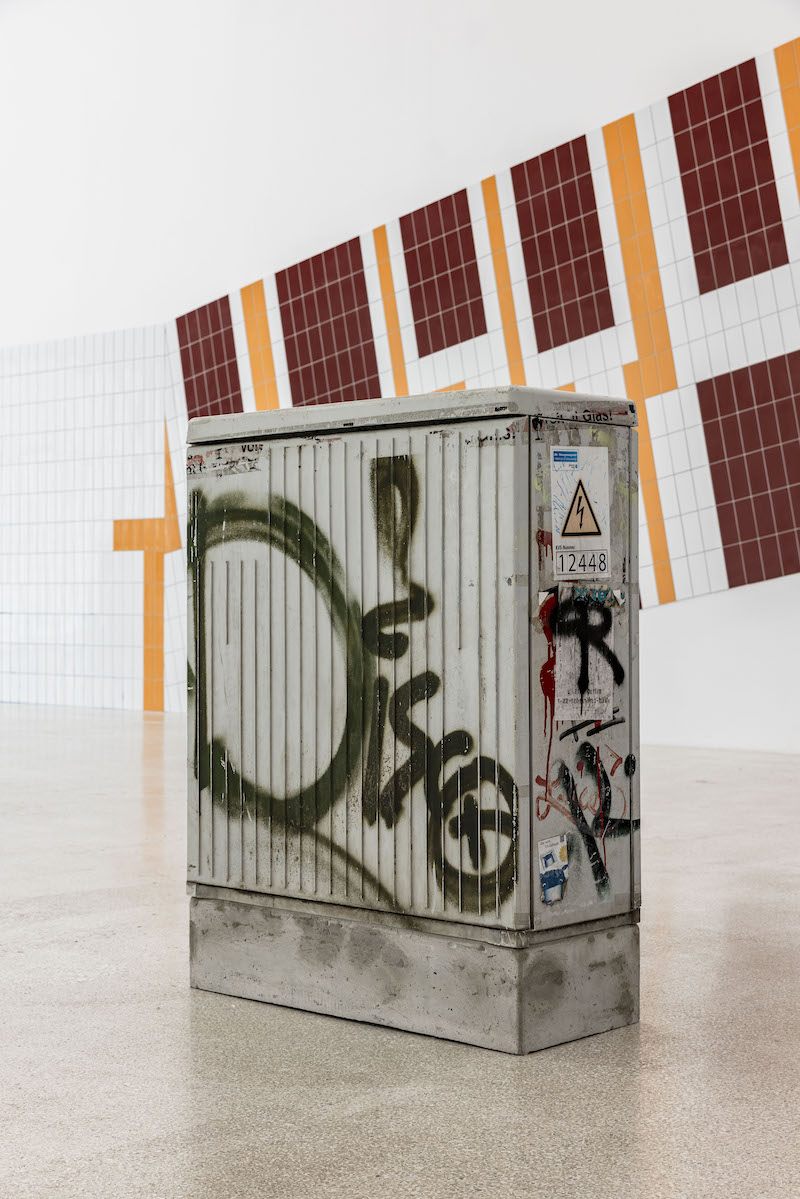by Chris Erik Thomas // Apr. 11, 2025
This article is part of our feature topic Public.
Graffiti is an art form of the people. From the moment aluminum spray paint was patented in 1951 for use on steam radiators, the readymade canisters have been co-opted to create. It was communities of Black and Hispanic teenagers in the outer boroughs of New York City who formed the first epicenter for the medium; the young taggers targeted subway cars, alleyways, trash cans—anywhere they could reach. Spray paint came to be seen as a tool of disobedience, amplified further by its use in the 1968 student and worker protests across France. The rapid proliferation of tagging and the draconian public policy campaigns to erase it gave graffiti a bad reputation almost immediately. Street art became the domain of vandals and troublemakers, a scourge on cities and the army of power-washers attempting to scrub it away. But like a plant sprouting up through the cracks in the pavement, graffiti endured.

‘Graffiti,’ 2025, installation view at Museion, from the left: Karin Sander: ‘Gebrauchsbild 170 q, Le Plateau, Paris,’ 2014; Karin Sander: ‘Gebrauchsbild 170b, Le Plateau, Paris,’ 2014, courtesy Esther Schipper, Berlin/Paris/Seoul // Photo by Luca Guadagnini
Over seven decades after its inception, tags can be seen all around the world—including via quick flashes glanced from a high-speed train heading to Bolzano. It’s in this northern Italian city that Museion has opened ‘Graffiti,’ the first Italian institutional exhibition to focus on the medium’s deep impact on contemporary art. It’s through the show that its co-curators, Museion’s Leonie Radine and New York-based artist, archivist and graffiti writer Ned Vena, have succeeded in rewriting the graffiti’s muddled narrative. This success lies partly in the balance between street and studio works, with the medium’s early taggers championed alongside the many artists who incorporated the canisters into their studio practice. But the show also works because, by enshrining this ephemeral medium in the pantheon of contemporary art history, Museion invites viewers to reconsider what it means to exist in the urban environment outside the museum walls.

‘Graffiti,’ 2025, exhibition view at Museion, from the left: WANTO, BOMBING LIFE: ‘The night party approaches,’ 2021-2022; ‘Phone booth,’ 2021-2022; ‘Throw away bike,’ 2021-2022; ‘Dark alleys of the big city,’ 2021-2022, Courtesy of the artist and Gallery Naruyama // Photo by Luca Guadagnini
“If you do something in the urban space, you can’t address anyone in particular,” Radine told us. “You can’t have an assumption of who’s going to see it because everyone could potentially see or no one could see it, because it might be gone the next morning.” The shelter of institutionalization preserves this oft-forgotten history, but there is also the risk of recontextualizing the work. Bringing one of the most important mediums for self-expression outside of the art world into it risks sanding off its edges—or worse, presenting the works like animals in a zoo for the public to entertain themselves with. In Julien Besançon’s 2018 book on the 1968 French protests, ‘The Walls Have the Floor,’ he writes that “graffiti itself became a form of freedom.” With the exhibition ‘Graffiti,’ this sense of freedom is preserved. The decision to present more than just works on canvas is key to showing the nebulous influence of the medium on everything from sculpture and installations to video and photography.

Klara Lidén: ‘Disco,’ 2020, Stedelijk Museum Amsterdam, gift of Sadie Coles HQ, London; Matias Faldbakken, TILE ESCALATION, 2025, Courtesy of the artist and Galerie Neu, Berlin, installation view from ‘Graffiti,’ 2025 at Museion // Photo by Luca Guadagnini
The exhibition confronts the medium’s “outsider” label from the jump. Ben Solomon’s ‘Dirty Laundry (False & Blake)’ (2023) opens the show. In the quick, minute-and-a-half film, a band of multicultural writers in New York illegally tag the streets; the camerawork is frenzied, swaying like a roving eye, as Don Henley’s ‘Dirty Laundry’ plays in the background. It’s loud, quick and establishes exactly what you might imagine as “modern graffiti”—before pulling the rug out just around the corner, with Romanian artist Hedda Sterne’s ‘Untitled’ (1955). As one of the earliest surviving works of spray paint on canvas, produced just four years after spray paint’s patent, the work is a kind of compass for the exhibition, offering not only an example of early spray paintings but also, as co-curator Radine notes, “an example of how we see graffiti in this exhibition as a way of looking at urban landscapes.”

‘Graffiti,’ 2025, installation view at Museion, from the left: Carol Rama: ‘Perdonami le congiunzioni,’ 1968; Carol Rama, ‘Untitled,’ 1968, Archivio Carol Rama, Torino, and Galerie Isabella Bortolozzi, Berlin; Dan Christensen: ‘O,’ 1968, courtesy of Berry Campbell, New York // Photo by Luca Guadagnini
The decision to cleave the show into two parts lends itself well to charting graffiti’s impact. The first section guides visitors through a series of rooms, offering a timeline of works from the pre-graffiti spray paintings of the 1950s and 1960s through to the present day, decade by decade. Early street art legends like Blade, Daze and Quik are honored alongside works by Keith Haring and Jenny Holzer. Further on, new ways of approaching the artform open up the concept of what graffiti can be. Armando Nin’s ‘Nunca en mi vida’ (2024) sees the artist use soot from a lighter as “paint”; the smoke marks are rendered on canvas in the same method graffiti writers used to tag ceilings. At a critical hinge just before the stairs leading to the second section, a series of new ‘Glypholyth’ candle works and site-specific wall tags by German graffiti writer N.O.Madski is presented in dialogue with sculptural ‘bodybags’ (2015) by the artist duo KAYA (Debo Eilers and N.O.Madski’s sister, Kerstin Brätsch). It’s through these body bags that KAYA conducted an artistic stress test into the limits of painting as they questioned, “what can you do with that medium, and how can you push it toward its edges?” It’s this question that echoes the goal of the exhibition: bend “spray paint” as a medium past its limits to break it open, showing all the strands of contemporary art that it inspired.

KAYA (Kerstin Brätsch & Debo Eilers): ‘Swarm Living is for Bodybag ONION BRAID,’ 2015 // Courtesy of the artists and Deborah Schamoni, installation view ‘Graffiti,’ 2025 at Museion // Photo by Luca Guadagnini
Juxtaposed against the labyrinth of works on Museion’s third floor, the fourth floor feels like a deep exhale as the exhibition opens into one large “cityscape,” a selection of works spread across the space. It’s here that graffiti becomes more than just a medium or a tool for creation; it becomes a mindset. In Charles Atlas’ ‘Ms. Peanut Visits New York’ (1992-99), the legendary queer performance artist Leigh Bowery traipses around the city’s Meatpacking District in Planter’s Peanut mascot drag. Bowery is the embodiment of graffiti’s countercultural spirit, blending into the graffiti-covered streets captured by Atlas’ lens. With Klara Lidén’s reclaimed trash cans and junction boxes taken from New York, Hamburg, Berlin and Stockholm and covered in tags, these found objects are reimagined as monuments to the traces people leave behind.

Leonie Radine
And then there is Josephine Pryde’s ‘New Media Express’ (2014), a fully functional miniature subway train covered in graffiti that up to four visitors can ride on as it curves through the middle of the show’s space. The experience of riding it may feel like being transported to a fun fair, but the work aims to be more than just a social media-friendly gimmick. For the British artist, who has shown the piece everywhere from Bristol and Berlin to the Venice Biennale, the train is an act of agitation, spurring the public to become more than just idle viewers. “I wanted to reactivate this question about the idea that art is more accessible if you can participate in it yourself.”

‘Graffiti,’ 2025, exhibition view at Museion // Photo by Luca Guadagnini
In his 2016 book ‘Landscapes,’ art critic John Berger writes: “After we have responded to a work of art, we leave it, carrying away in our consciousness something which we didn’t have before […] What we take away with us—on the most profound level—is the memory of the artist’s way of looking at the world.” Like a tree falling in a forest and nobody being around to hear it, art is activated by interaction. Next year, as part of a collaboration between institutions, the Centraal Museum, Utrecht will present its own exhibition on graffiti, allowing a new throng of visitors to rethink the practice. But for now, spray paint’s power as a tool for public expression is easy to spot. Almost as soon as they were put up, posters spread across Bolzano advertising the exhibition began to be reclaimed, their text obscured by fresh tags.
Exhibition Info
Museion
Group Show: ‘Graffiti’
Exhibition: Mar. 29-Sept. 14, 2025
museion.it
Piazza Piero Siena, 1, 39100 Bolzano BZ, Italy, click here for map





















